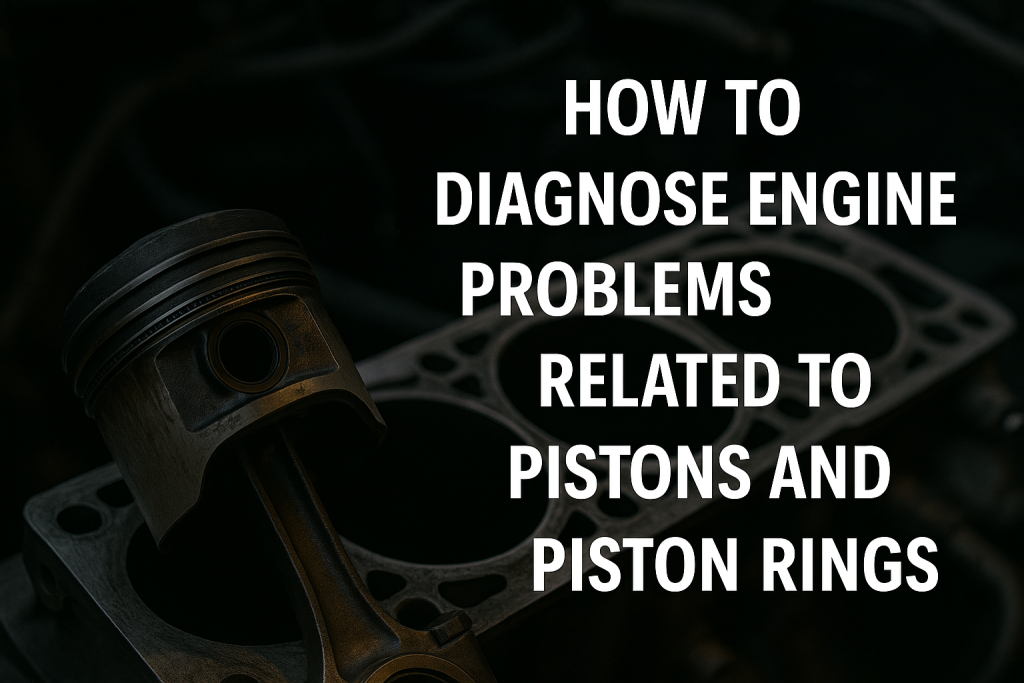Introduction
Is your engine consuming more oil than usual? Experiencing a significant drop in power or hearing strange knocking noises? These could be tell-tale signs of internal engine problems, particularly involving pistons and piston rings. The health of these components is crucial to the overall performance of your engine, as they play a vital role in sealing the combustion chamber and maintaining optimal pressure. Diagnosing engine problems related to pistons and piston rings early can save you from a complete engine overhaul and extend your vehicle’s lifespan.
By catching these issues in their early stages, you can not only avoid costly repairs but also ensure that your vehicle runs smoothly and efficiently for years to come. In this post, we’ll break down the most effective ways to identify piston-related issues before they escalate, providing you with the knowledge you need to keep your engine in top condition
Why Pistons and Piston Rings Matter in Engine Health
Pistons and piston rings play a critical role in an engine’s combustion process. Pistons move up and down inside the cylinder, compressing the air-fuel mixture before ignition. Piston rings seal the combustion chamber, prevent oil from leaking into the cylinder, and aid in heat transfer.
If either the piston or the rings are compromised, you may face issues like:
-
Poor compression
-
Oil leaks or consumption
-
Smoke from the exhaust
-
Reduced engine performance
Let’s take a look at how you can pinpoint these issues accurately.
Common Symptoms of Piston and Piston Ring Failure
Here are signs that suggest a problem with your pistons or piston rings:
-
Excessive Oil Consumption: A damaged oil control ring will allow oil to enter the combustion chamber.
-
Blue Smoke from Exhaust: Indicates burning oil—a key symptom of worn piston rings.
-
Loss of Engine Power: Compression loss from piston ring wear reduces overall power output.
-
Engine Misfires: Damaged pistons can result in poor combustion.
-
Knocking Sounds: Often linked to piston slap or damage within the cylinder.
Step-by-Step Guide to Diagnosing Piston and Piston Ring Issues
Conduct a Compression Test
A compression test is one of the most effective diagnostic tools for internal engine problems.
-
Remove the spark plugs.
-
Install a compression gauge into the spark plug hole.
-
Crank the engine several times and note the reading.
Low or uneven compression across cylinders usually points to piston ring wear or damaged pistons.
Perform a Leak-Down Test
This test helps pinpoint where compression is leaking from:
-
Pressurize each cylinder individually.
-
Listen for air escaping through the oil filler cap (piston rings), intake manifold (intake valve), or exhaust (exhaust valve).
If air escapes through the crankcase, it’s likely the piston rings are worn or damaged.
Check for Oil in the Combustion Chamber
Remove the spark plugs and inspect them. If they appear oily or fouled, it indicates oil seepage due to failed piston rings.
Inspect Engine Smoke
Observe your exhaust smoke:
-
Blue Smoke: Burning oil due to piston ring failure.
-
White Smoke: Coolant in the combustion chamber—possibly a cracked piston.
-
Black Smoke: Excessive fuel—though not always piston-related, it can be tied to inefficient combustion.
Listen for Unusual Engine Noises
A knocking or slapping sound when the engine is cold, but which fades when warm, could point to piston slap—often a result of piston wear or damage.
Causes of Piston and Piston Ring Problems
-
Overheating: Causes piston expansion, ring sticking, or ring land damage.
-
Poor Lubrication: Insufficient oil can lead to ring scuffing and piston scoring.
-
Detonation/Pre-Ignition: Uncontrolled combustion leads to piston cracking or holes.
-
High Mileage: Over time, piston rings naturally wear and lose sealing ability.
Preventive Maintenance Tips
-
Regular oil changes using manufacturer-recommended oil
-
Avoid overheating and ensure coolant system is functional
-
Use high-quality fuel to reduce carbon buildup
-
Warm up the engine before high RPM usage
Should You Repair or Replace the Pistons and Rings?
If diagnostics confirm ring or piston failure, a teardown is necessary. Depending on the severity:
-
Light scoring or wear: May only require re-ringing
-
Cracked pistons or damaged ring lands: Full piston replacement
-
Cylinder damage: May require honing or even reboring
Always consult a qualified mechanic before proceeding with repairs.
Diagnose Engine Problems Pistons Piston Rings
If you want your vehicle to last, knowing how to diagnose engine problems related to pistons and piston rings is crucial. Early signs like blue smoke, oil consumption, or power loss shouldn’t be ignored. Conducting basic diagnostic tests like compression and leak-down analysis can help pinpoint the root cause, saving you money and engine headaches down the road.
FAQs
What causes piston rings to fail?
Piston rings can fail due to poor lubrication, overheating, high mileage, or detonation.
How long do piston rings last?
They can last over 100,000 miles with proper maintenance, but driving habits and engine conditions matter.
Can I drive with bad piston rings?
It’s possible but not advisable. You’ll experience reduced power and increased oil consumption, which can further damage the engine.
Is blue smoke always a sign of bad piston rings?
Not always, but it is a strong indicator. It’s best to confirm with diagnostic testing.
Conclusion
Understanding how to diagnose engine problems related to pistons and piston rings is not just for mechanics—it’s essential for every car owner. With the right knowledge and timely action, you can prevent costly engine rebuilds, maintain performance, and ensure your vehicle runs smoothly for years. Don’t ignore the signs—listen to your engine, check your oil, and keep those pistons and rings in top condition.



